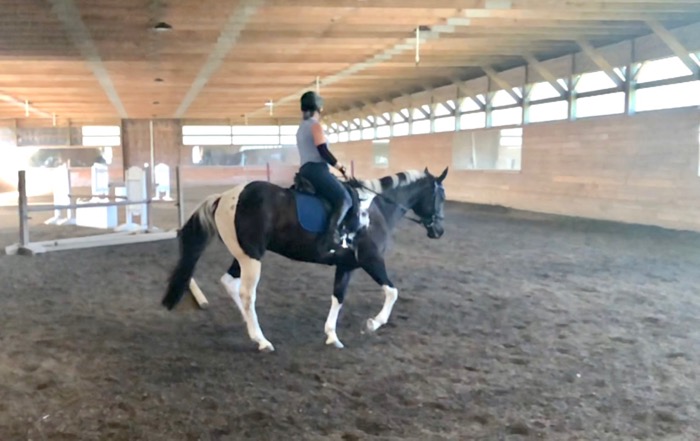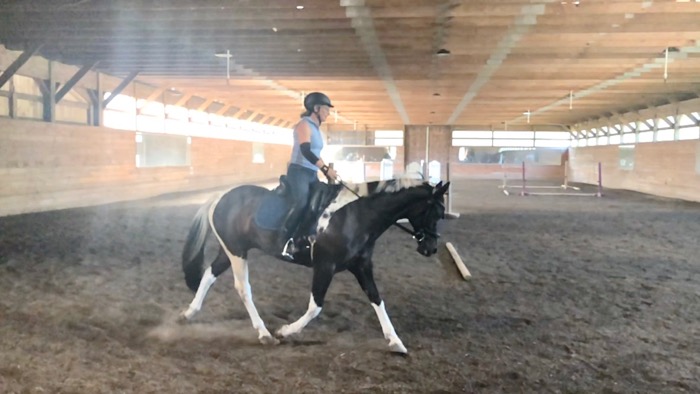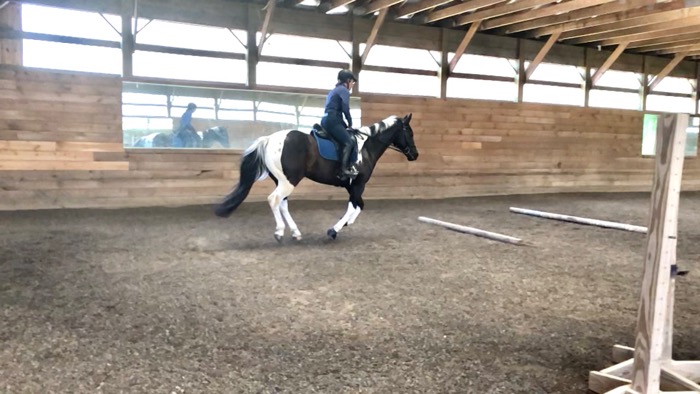Last week, my friend Emily came to visit. Emily is brilliant. She’s a professor who teaches thought-provoking classes like one that delves into how lessons learned from epic ancient poetry can help defeat despotism.
We first met at Vershire Riding School in 1973. When we see each other, which isn’t often, we gab. Once in awhile we talk about all of that serious stuff that she knows, but mostly, we talk about what we’ve talked about for our four decades of friendship. Horses. Of course, when she visits, we see Tonka. I asked her to video my ride. Emily is brilliant, but not great with technology. After she left, I watched the recording and saw that she’d hit the slo-mo button instead of video.
Why hadn’t I thought of doing that? Slo-mo shows exactly how Tonka is moving. Regular video has gaps. With regular video, I’d obsess over frames, but couldn’t see complete strides. With slo-mo, I could see everything! Watching the trot, I could see the over-reach and the hock action, but I could also see the moment that each hind toe dips and drags.
The canter slo-mo was also revealing.
The canter is a 3- beat gait with a moment of suspension. But Tonka was keeping his leading foreleg on the ground until the hind touched down. No suspension.

A recent thorough veterinarian exam didn’t uncover any obvious points of pain or issues in the leg joints. Stifle x-rays are clear. Tonka’s been going fluidly and willingly under saddle.

Partly I think that what’s going on is muscle memory. This is how he learned to move when his lumbar area hurt, and so it’s what he still does. Partly he’s weak in the stifles, so lifting off his hind end, and staying suspended, is hard work. The remedy is to set up exercises that build his strength where he needs it.
Poles.

Hills.

At the canter, Tonka needs to learn that he can do that moment of suspension. We’re cantering through poles 8-feet part so he has to bounce through them. Tonka thinks it’s fun! A few times through and even on the approach he’s more up in the forehand and pushing off of the hind.

I’m enjoying this focus to our work. It’s forward and it’s varied, and it can be done in the ring, and out. The weather is glorious. The deer flies are waning. The field at Tonka’s stable was just mowed. Yesterday, doing big walk, trot and canter circles in that gently rolling field, we covered three miles. Tonka is still figuring out how to use his body on the downhills. I encourage him to use his top line instead of inverting and bracing. He is, and I can almost feel him say, Oh! This is how to move. Fun!

At the end of September, I’ll take more slo-mo videos to see if this cross-training has improved Tonka’s gaits. Maybe Emily will come back to hit the slo-mo button!
Have you used slo-mo video to evaluate your horse’s gait? If not, give it a try and tell me what you observe!


Technological ineptitude has its virtues!
And you only got your thumb on the lens once 🙂
Really valued seeing this. He looks like he feels good at the trot – really seeking the bit and your contact is so nice and fluid. And at the canter, VERY interesting to see his front still on the ground when the hind lands. Thanks for sharing. Will do slo mo the next time I ride too.
He feels super under-saddle at the trot, which is why this slo-mo was insightful. I had no idea about that toe drag. Let me know what you see in your video!
What a happy accident! Im definitely going to have to try the slomo video! What I’m seeing on the canter is that his outside hind isn’t coming under fully, it’s landing too soon. Both hinds at the trot look like they are landing in or just ahead of the front foot tracks, rather than several inches in front.
The cross training is bound to help build fitness and help with mental stimulation 🙂 hill work is my favorite way to build the hind end.
Enjoy it, and your lovely boy, he looks like he’s full of try!